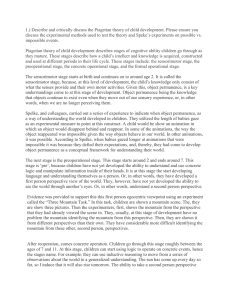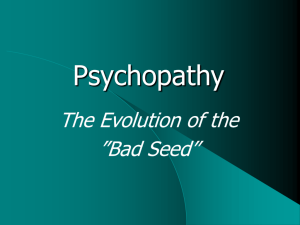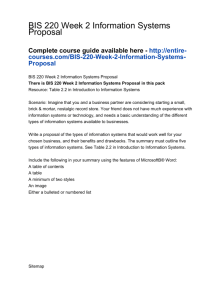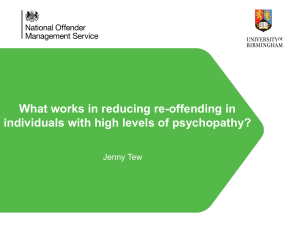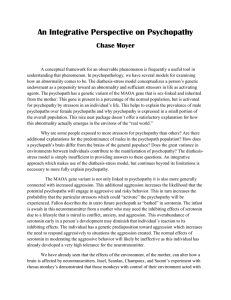Validating a Distinction Between Primary and Secondary
advertisement
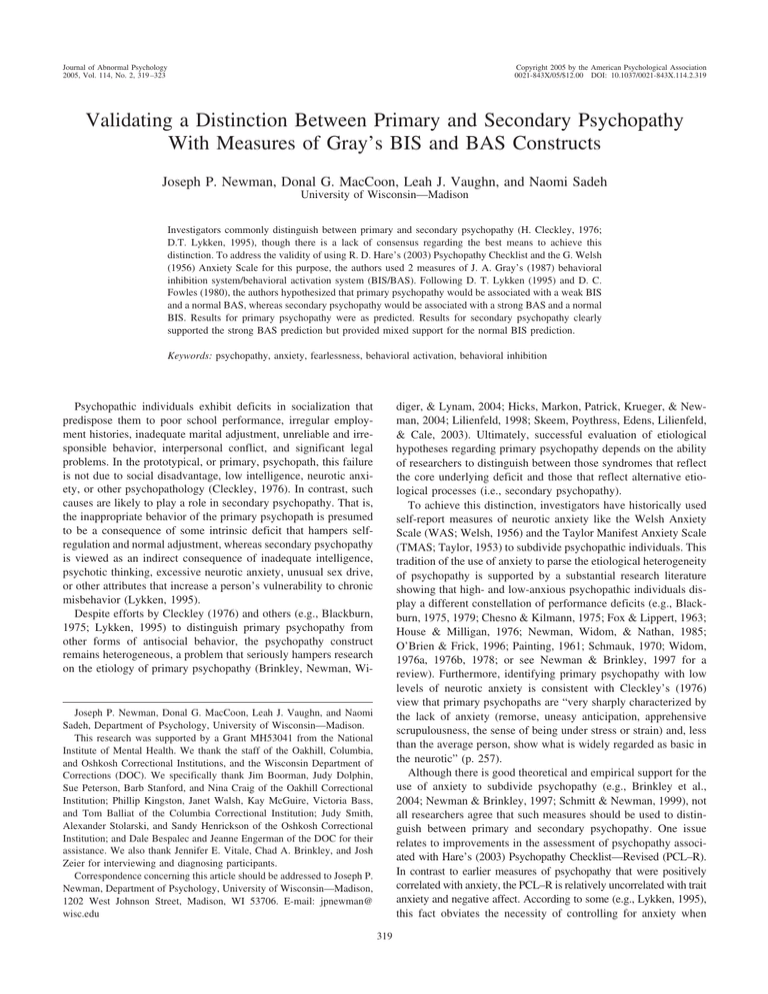
Journal of Abnormal Psychology 2005, Vol. 114, No. 2, 319 –323 Copyright 2005 by the American Psychological Association 0021-843X/05/$12.00 DOI: 10.1037/0021-843X.114.2.319 Validating a Distinction Between Primary and Secondary Psychopathy With Measures of Gray’s BIS and BAS Constructs Joseph P. Newman, Donal G. MacCoon, Leah J. Vaughn, and Naomi Sadeh University of Wisconsin—Madison Investigators commonly distinguish between primary and secondary psychopathy (H. Cleckley, 1976; D.T. Lykken, 1995), though there is a lack of consensus regarding the best means to achieve this distinction. To address the validity of using R. D. Hare’s (2003) Psychopathy Checklist and the G. Welsh (1956) Anxiety Scale for this purpose, the authors used 2 measures of J. A. Gray’s (1987) behavioral inhibition system/behavioral activation system (BIS/BAS). Following D. T. Lykken (1995) and D. C. Fowles (1980), the authors hypothesized that primary psychopathy would be associated with a weak BIS and a normal BAS, whereas secondary psychopathy would be associated with a strong BAS and a normal BIS. Results for primary psychopathy were as predicted. Results for secondary psychopathy clearly supported the strong BAS prediction but provided mixed support for the normal BIS prediction. Keywords: psychopathy, anxiety, fearlessness, behavioral activation, behavioral inhibition diger, & Lynam, 2004; Hicks, Markon, Patrick, Krueger, & Newman, 2004; Lilienfeld, 1998; Skeem, Poythress, Edens, Lilienfeld, & Cale, 2003). Ultimately, successful evaluation of etiological hypotheses regarding primary psychopathy depends on the ability of researchers to distinguish between those syndromes that reflect the core underlying deficit and those that reflect alternative etiological processes (i.e., secondary psychopathy). To achieve this distinction, investigators have historically used self-report measures of neurotic anxiety like the Welsh Anxiety Scale (WAS; Welsh, 1956) and the Taylor Manifest Anxiety Scale (TMAS; Taylor, 1953) to subdivide psychopathic individuals. This tradition of the use of anxiety to parse the etiological heterogeneity of psychopathy is supported by a substantial research literature showing that high- and low-anxious psychopathic individuals display a different constellation of performance deficits (e.g., Blackburn, 1975, 1979; Chesno & Kilmann, 1975; Fox & Lippert, 1963; House & Milligan, 1976; Newman, Widom, & Nathan, 1985; O’Brien & Frick, 1996; Painting, 1961; Schmauk, 1970; Widom, 1976a, 1976b, 1978; or see Newman & Brinkley, 1997 for a review). Furthermore, identifying primary psychopathy with low levels of neurotic anxiety is consistent with Cleckley’s (1976) view that primary psychopaths are “very sharply characterized by the lack of anxiety (remorse, uneasy anticipation, apprehensive scrupulousness, the sense of being under stress or strain) and, less than the average person, show what is widely regarded as basic in the neurotic” (p. 257). Although there is good theoretical and empirical support for the use of anxiety to subdivide psychopathy (e.g., Brinkley et al., 2004; Newman & Brinkley, 1997; Schmitt & Newman, 1999), not all researchers agree that such measures should be used to distinguish between primary and secondary psychopathy. One issue relates to improvements in the assessment of psychopathy associated with Hare’s (2003) Psychopathy Checklist—Revised (PCL–R). In contrast to earlier measures of psychopathy that were positively correlated with anxiety, the PCL–R is relatively uncorrelated with trait anxiety and negative affect. According to some (e.g., Lykken, 1995), this fact obviates the necessity of controlling for anxiety when Psychopathic individuals exhibit deficits in socialization that predispose them to poor school performance, irregular employment histories, inadequate marital adjustment, unreliable and irresponsible behavior, interpersonal conflict, and significant legal problems. In the prototypical, or primary, psychopath, this failure is not due to social disadvantage, low intelligence, neurotic anxiety, or other psychopathology (Cleckley, 1976). In contrast, such causes are likely to play a role in secondary psychopathy. That is, the inappropriate behavior of the primary psychopath is presumed to be a consequence of some intrinsic deficit that hampers selfregulation and normal adjustment, whereas secondary psychopathy is viewed as an indirect consequence of inadequate intelligence, psychotic thinking, excessive neurotic anxiety, unusual sex drive, or other attributes that increase a person’s vulnerability to chronic misbehavior (Lykken, 1995). Despite efforts by Cleckley (1976) and others (e.g., Blackburn, 1975; Lykken, 1995) to distinguish primary psychopathy from other forms of antisocial behavior, the psychopathy construct remains heterogeneous, a problem that seriously hampers research on the etiology of primary psychopathy (Brinkley, Newman, Wi- Joseph P. Newman, Donal G. MacCoon, Leah J. Vaughn, and Naomi Sadeh, Department of Psychology, University of Wisconsin—Madison. This research was supported by a Grant MH53041 from the National Institute of Mental Health. We thank the staff of the Oakhill, Columbia, and Oshkosh Correctional Institutions, and the Wisconsin Department of Corrections (DOC). We specifically thank Jim Boorman, Judy Dolphin, Sue Peterson, Barb Stanford, and Nina Craig of the Oakhill Correctional Institution; Phillip Kingston, Janet Walsh, Kay McGuire, Victoria Bass, and Tom Balliat of the Columbia Correctional Institution; Judy Smith, Alexander Stolarski, and Sandy Henrickson of the Oshkosh Correctional Institution; and Dale Bespalec and Jeanne Engerman of the DOC for their assistance. We also thank Jennifer E. Vitale, Chad A. Brinkley, and Josh Zeier for interviewing and diagnosing participants. Correspondence concerning this article should be addressed to Joseph P. Newman, Department of Psychology, University of Wisconsin—Madison, 1202 West Johnson Street, Madison, WI 53706. E-mail: jpnewman@ wisc.edu 319 320 BRIEF REPORTS using the PCL–R. However, the fact that anxiety and PCL–R scores are uncorrelated does not ensure that individuals identified as psychopathic have low levels of neurotic anxiety. Rather, it indicates that, on average, psychopaths will be as likely to report above normal anxiety as below normal anxiety (see Schmitt & Newman, 1999). A second concern relates to the distinction between anxiety and fearfulness (e.g., Lilienfeld, 1994, 1998; Lykken, 1957, 1995). According to Lykken (1995), primary psychopathy is characterized by fearlessness, poor passive avoidance, weak electrodermal anticipation of punishment, and average levels of positive and negative emotionality. Secondary psychopathy, by contrast, is characterized by relatively high levels of positive and negative emotionality, impulsiveness, and sensation seeking but average levels of fearlessness, passive avoidance, and electrodermal activity in anticipation of punishment. In addition, Lykken has used Gray’s (1987) conceptual model of the nervous system to clarify his distinction between primary and secondary psychopathy. Gray’s model postulates two primary motivational systems: the behavioral activation system (BAS) and the behavioral inhibition system (BIS). The BAS is sensitive to reward cues and initiates behavioral approach, whereas the BIS is sensitive to punishment cues and initiates passive avoidance. In Gray’s model, both motivational systems serve to increase nonspecific (i.e., general) arousal and they are reciprocally related such that activation of one system inhibits activation of the other. According to Lykken, primary psychopathy is associated with a hyporeactive BIS and average BAS, whereas secondary psychopathy is associated with a hyperreactive BAS and average BIS. On the basis of this characterization of primary and secondary psychopathy, Lykken (1957, 1995) has argued that investigators should use measures of fearlessness (e.g., harm avoidance/constraint; Tellegen, 1982) to distinguish between primary and secondary psychopathy. Moreover, because fearlessness is essentially uncorrelated with measures of anxiety–negative emotionality such as the WAS and TMAS (Watson & Clark, 1984), Lykken has expressed strong reservations about the use of anxiety scales to distinguish between primary and secondary psychopathy. Given the methodological and theoretical importance of this question and the lack of empirical evidence documenting the postulated associations, there is a strong need for empirical research to address the validity of alternative methods for identifying primary and secondary psychopathy. Toward this end, we examine the extent to which primary and secondary psychopathy identified with the PCL–R and WAS satisfy Lykken’s (1995) criteria with respect to Gray’s (1987) BIS and BAS constructs. Our focus on Gray’s (1987) BIS/BAS systems reflects their prominence in models of primary and secondary psychopathy (e.g., Fowles, 1980; Lykken, 1995) and the absence of empirical evidence involving well-validated measures of these constructs. We hypothesize that (a) primary psychopathy identified through the use of a combination of high PCL–R- and low-WAS scores will be characterized by a weak BIS and a normal (i.e., average) BAS and (b) secondary psychopathy identified through the use of a combination of high PCL–R and high-WAS scores will be characterized by a strong BAS and normal (i.e., average) BIS. In other words, we predict that the BIS/BAS profiles that Lykken associates with primary and secondary psychopathy will be satisfied by using the PCL–R and WAS to identify these groups. Method Participants Participants consisted of 517 (342 European American, 175 African American) male inmates residing at minimum-, medium-, and maximumsecurity prisons in Wisconsin. Participants were included if they were age 45 or younger; not currently taking psychotropic medication; had no history of schizophrenia, bipolar disorder, or psychosis not otherwise specified; and attained a reading level of 4th grade or better on Department of Corrections administered achievement tests. In addition, all participants earned estimated IQ scores of 70 or greater on the Shipley Institute of Living Scale (SILS; Zachary, 1986), had PCL–R scores that qualified as psychopathic or nonpsychopathic according to the standard cut-scores (ⱕ 20 or ⱖ 30), and completed the WAS. A subset of 507 participants (335 European American, 172 African American) completed the Sensitivity to Punishment and Sensitivity to Reward Questionnaire (SPSRQ; Torrubia, Ávila, Moltó, & Caseras, 2001), 251 (204 European American, 47 African American) completed the BIS/BAS Scales (Carver & White, 1994), and 241 (197 European American, 44 African American) completed both measures. All participants received the elements of consent in both verbal and written form and were informed that participation in the project would have no effect on their status within the correctional system. Assessment and Classification PCL–R. Researchers used file information and a 60-min semistructured interview to diagnose psychopathy through the use of the PCL–R. The PCL–R contains 20 items that are rated 2, 1, or 0 according to whether an individual exhibits a characteristic significantly (2), moderately (1), or not at all (0). Following the recommendations of Hare (1991), we classified individuals with scores of 30 and above as psychopathic and those with scores of 20 or less as nonpsychopathic. The reliability and validity of the PCL–R is well documented (e.g., Hare, 1991, 1996). During the time that the data for this study were collected, we completed two independent PCL–R ratings for 101 individuals. Using intraclass correlation, we found the interrater reliability to be .96. Limiting this analysis to the 65 individuals rated as psychopathic or nonpsychopathic by the two raters and using the kappa statistic, we also found interrater reliability to be .96. Questionnaire measures. The WAS is a 39-item true–false scale derived from the Minnesota Multiphasic Personality Inventory that measures anxiety and negative affect more generally (see Schmitt & Newman, 1999; Watson & Clark, 1984). According to Welsh (1956), the WAS has four major item clusters: trouble concentrating (e.g., finding it hard to keep focused on a task or job), negative affect (e.g., feeling anxiety about something or someone almost all the time), low energy/pessimism (e.g., feeling that life is a strain most of the time), personal sensitivity (e.g., feeling that strangers are looking at one critically). The SPSRQ (Torrubia et al., 2001) is a 48-item yes–no measure that consists of two scales: Sensitivity to Punishment (SP; 24 items) and Sensitivity to Reward (SR; 24 items), that demonstrate good reliability and construct validity (Ávila & Parcet, 2000, 2001; Caseras, Ávila, & Torrubia, 2003). The SP scale assesses individual differences in BIS functioning, including behavioral inhibition in response to novelty or punishment cues (e.g., frequent fear of new or unexpected situations), and cognitive worry in response to failure or punishment cues (e.g., often refraining from doing something one likes in order not to be rejected or disapproved of by others). The SR scale measures individual differences in BAS functioning, including sensation seeking and approach behavior in situations involving access to rewards (e.g., the good prospect of obtaining money is a strong motivator). The BIS/BAS Scales (Carver & White, 1994) is a 20-item questionnaire with four scales: BIS (7 items), BAS—Reward Responsiveness (5 items), BAS—Drive (4 items) and BAS—Fun Seeking (4 items). Each item is rated on a 4-point scale ranging from 1 (strongly agree) to 4 (strongly disagree). The BIS subscale assesses sensitivity to aversive stimuli (e.g., BRIEF REPORTS worrying about making mistakes), whereas the BAS—Reward Responsiveness, Drive, and Fun Seeking subscales measure sensitivity to anticipated/ acquired rewards, motivation to achieve desired goals, and willingness to approach new appetitive stimuli, respectively. Because all three BAS subscales load strongly on a second-order (BAS) factor, we tested our hypotheses with the total BAS score. Classification Participants were divided into groups on the basis of PCL–R scores and a median split on the WAS. Primary psychopathy was defined as having a PCL–R score of 30 or greater and a WAS score of 11 or less. Secondary psychopathy was defined as having a PCL–R score of 30 or greater and a WAS score of 12 or more. In order to make the comparison groups for these two groups as comparable as possible, we performed statistical analyses to compare (a) individuals meeting criteria for primary psychopathy with all participants not meeting these criteria and (b) individuals meeting criteria for secondary psychopathy with all participants not meeting these criteria. Table 1 provides cell sizes, means, and standard deviations for these groups on the two assessments of Gray’s (1987) motivational systems. To facilitate comparison across measures, we report z scores for SR/SP and BAS/BIS measures. Table 2 shows the nonstandardized means and standard deviations for these measures along with relevant correlations. Results Preliminary analyses examined the effects of race in moderating the association between group and the dependent measures used in the following analyses. In no case, did the Group ⫻ Race interaction approach statistical significance (all ps ⬎ .20). To test the hypothesis that primary psychopathy is associated with a weak BIS and a normal BAS relative to control participants, we conducted a mixed-model analysis of variance (ANOVA) with group (primary psychopathy, control) as the between-participants variable and motivational system (SP, SR) as the repeated measure. Consistent with our hypothesis, the ANOVA revealed a significant Group ⫻ Motivational System interaction, F(1, 505) ⫽ 39.95, p ⬍ .001, 2 ⫽ .073. As shown in Table 1, SP scores for the primary psychopathy group were significantly smaller than those for controls, F(1, 505) ⫽ 67.83, p ⬍ .001, 2 ⫽ .12, whereas SR scores were comparable for the two groups, F(1, 505) ⬍ 1.0, ns. 321 Table 2 Nonstandardized Means, Standard Deviations, and Correlations for SRSPQ, BIS/BAS, and WAS Measures Variable 1 SPa SRa BISb BASb WAS — — — — — 1. 2. 3. 4. 5. 2 .21* — — — — 3 4 5 M SD .49* .09 — — — .04 .54* .16 — — .67* .32* .35* .18* — 8.90 13.00 18.60 38.60 12.20 5.40 4.90 3.70 6.00 8.60 Note. SP ⫽ Sensitivity to Punishment subscale; SR ⫽ Sensitivity to Reward subscale; BIS ⫽ behavioral inhibition system; BAS ⫽ behavioral activation system; WAS ⫽ Welsh Anxiety Scale. a n ⫽ 241 for correlations with BIS and BAS; n ⫽ 511 for all other correlations. b n ⫽ 241 for correlations with SP and SR; n ⫽ 251 for all other correlations. * p ⬍ .05. Paralleling results for the SR/SP analysis, an ANOVA that used the BIS/BAS scales yielded a significant Group ⫻ Motivational System interaction, F(1, 249) ⫽ 14.06, p ⬍ .001, 2 ⫽ .05. Consistent with predictions, the BIS scores of the primary psychopathy group were significantly lower than those of controls, F(1, 249) ⫽ 28.45, p ⬍ .001, 2 ⫽ .10, whereas the BAS scores of the two groups did not approach statistical significance, F(1, 249) ⬍ 1.0. To test the hypothesis that secondary psychopathy is associated with a strong BAS and a normal BIS relative to control participants, we conducted a mixed-model ANOVA with group (secondary psychopathy, control) as the between-participants variable and motivational system (SP, SR) as the repeated measure. Consistent with our hypothesis, the ANOVA revealed a significant Group ⫻ Motivational System interaction, F(1, 505) ⫽ 8.94, p ⫽ .003, 2 ⫽ .02. As predicted, SR scores for the secondary psychopathy group were significantly greater than those for control participants, F(1, 505) ⫽ 49.68, p ⬍ .001, 2 ⫽ .09. Contrary to prediction, SP scores were also significantly greater in the secondary psychopathy group, F(1, 505) ⫽ 9.15, p ⫽ .003, 2 ⫽ .02. The ANOVA that used the BIS/BAS scales also yielded a significant Group ⫻ Motivational System interaction, F(1, 249) ⫽ Table 1 Means and Standard Deviations for z-Scored SPSRQ and BIS/BAS Scales by Group Primary psychopathy Sample and statistic SP n M SD ⫺0.67a 0.58 107 BIS n M SD ⫺0.53d 0.83 67 Primary psychopathy control participants SR SP ⫺0.01 0.97 0.18a 1.00 BAS BIS ⫺0.04 0.98 Secondary psychopathy SR SP 0.00 1.00 0.25b 0.94 BAS BIS 400 0.19d 0.98 SR SP 0.57c 0.78 ⫺0.07b 1.00 BAS BIS 110 184 53 0.01 1.00 0.16 0.97 Secondary psychopathy control participants 0.59e 0.84 ⫺0.05 1.00 SR 397 ⫺0.16c 1.00 BAS 198 ⫺0.16e 0.99 Note. Items with the same subscript are significantly different at the p ⬍ .05 level. SP ⫽ Sensitivity to Punishment subscale; SR ⫽ Sensitivity to Reward subscale; BIS ⫽ behavioral inhibition system; BAS ⫽ behavioral activation system. BRIEF REPORTS 322 7.63, p ⫽ .006, 2 ⫽ .03. Consistent with predictions, the BAS scores of the secondary psychopathy group were significantly greater than those of control participants, F(1, 249) ⫽ 25.51, p ⬍ .001, 2 ⫽ .09, whereas the BIS scores of the two groups failed to reach statistical significance, F(1, 249) ⬍ 1.73, ns. Discussion Our results provide strong support for the hypothesis that primary psychopathy, as identified by high-PCL–R and low-WAS scores, is characterized by a weak BIS and a normal BAS. Across two different measures of the BIS and BAS constructs, the primary psychopathy group was associated with significantly lower BIS scores (mean z score ⫽ ⫺.60) and normal BAS scores (mean z-score ⫽ ⫺.025). This finding serves simultaneously to bolster Lykken’s (1995) characterization of primary psychopathy and the utility of using traditional measures of anxiety such as the WAS to distinguish primary psychopathy from other antisocial syndromes. Results for the secondary psychopathy group are also consistent with Lykken’s (1995) predictions and provide additional support for the use of the WAS to differentiate primary and secondary psychopathy. Across two measures of the construct, secondary psychopathy was associated with significantly higher BAS scores (mean z score ⫽ .58) than control participants. On the basis of Lykken’s characterization of secondary psychopathy, we also predicted that secondary psychopathy would be associated with average BIS scores, but this prediction received only partial support (mean z score ⫽ .205), with one of the comparisons yielding a significant group difference. Despite this limitation, both analyses yielded significant Group ⫻ Motivational Construct interactions with the secondary psychopathy group distinguished primarily by their scores on the BAS measures. Moreover, in light of Lykken’s claim that secondary psychopathy involves “high scores on negative emotionality or neuroticism” (p. 122) and Gray’s (1987) claim that BIS activation increases with increasing levels of neuroticism, the modest correlation between secondary psychopathy and the BIS construct is not very surprising. One limitation of the current findings is that they are restricted to self-report indices of BIS and BAS functioning and, thus, do not address the behavioral (e.g., passive avoidance) and physiological indices (electrodermal hyporeactivity) of BIS functioning identified by Lykken (1995). However, there is already published evidence demonstrating that poor passive avoidance is more strongly related to primary psychopathy than to secondary psychopathy as defined in this study (e.g., Newman & Schmitt, 1998). Results for electrodermal hyporeactivity are more equivocal. Evaluating predictions from the Fowles (1980) model of psychopathy, Arnett (1997) found that group differences in electrodermal responses to punishment cues were specific to comparisons involving highanxious (i.e., secondary) psychopaths and control participants. Although this result appears counterintuitive, Fowles (2000) has noted that psychopathic individuals’ electrodermal hyporeactivity in anticipation of aversive stimuli “may relate to an impulsivity dimension among psychopaths rather than to the core personality features of psychopathy” (p. 177; see also, Gatzke-Kopp, Raine, Loeber, Stouthamer-Loeber, & Steinhauer, 2002). Indeed, there is growing awareness that many correlates of psychopathy initially attributed to weak BIS functioning, and low levels of neurotic anxiety may actually reflect a low constraint/impulsivity dimension that is more associated with the antisocial lifestyle aspect of psychopathy (i.e., PCL–R, Factor 2) and secondary (i.e., highanxious) psychopathy than with primary psychopathy (Hicks et al., 2004; Newman, 1997; Schmitt & Newman, 1999). Another potential limitation is that because Gray (1982, 1987) characterized his BIS as a hypothetical anxiety system and, in large part, based his model on the effects of antianxiety drugs (e.g., benzodiazepines), its association with a definition of primary psychopathy that includes low anxiety could be construed as circular and as undermining the significance of the current study. In this regard, it is worth noting that (a) the BIS and the WAS measures were only moderately correlated (r ⫽ .35); (b) although the correlation between the SP and the WAS was much higher (r ⫽ .67), results for the BIS and the SP scales were virtually identical, indicating that our results were not simply a reflection of the magnitude of correlation between the WAS and measures of the BIS construct; (c) partialing the effects of anxiety from the group analyses does not eliminate the significant effects reported; (d) despite the correlation between the WAS and the BIS measures, secondary psychopathy was more strongly related to the BAS than to the BIS constructs; and (e) others (e.g., Fowles & Missel, 1994; Lykken, 1995) have proposed that the BIS deficiencies associated with psychopathy are attributable to fearlessness and low constraint rather than to low anxiety. Finally, regardless of the processes responsible for the association, our results provide good empirical support for the use of the WAS to distinguish primary and secondary psychopathy. Despite these potential limitations, the current investigation provides an important addition to the field of psychopathy. To our knowledge, the current investigation is the first to provide evidence that primary psychopathy is differentially associated with the BIS construct (i.e., relatively uncorrelated with BAS) and that secondary psychopathy is significantly and differentially associated with the BAS construct. This demonstration has potentially important implications for models that relate psychopathy to Gray’s (1987) motivational systems (e.g., Arnett, 1997; Fowles, 1980; Quay, 1988). As proposed by Fowles (1980), many findings in psychopathy appear to reflect weak BIS functioning, but this characterization may not apply to high-anxious psychopathic individuals. Similarly, Arnett (1997) and others (e.g., Quay, 1988) have characterized psychopathy as BAS- or reward-dominant, but this description may apply specifically to secondary psychopathy as opposed to primary psychopathy. More generally, without assessing anxiety and distinguishing between primary and secondary psychopathy, a significant difference between psychopathic and nonpsychopathic participants may reflect weak BIS functioning, strong BAS functioning, or BAS versus BIS dominance. This problem was also highlighted by Lykken (1995) when he noted that secondary psychopathy may mimic primary psychopathy because a strong BAS may overwhelm a person’s normal BIS and mimic the fear deficit that he associates with primary psychopathy. These and other sources of confusion can be avoided through the clarification of the diverse etiological processes associated with primary and secondary psychopathy. The current study suggests that measures of anxiety can help make this distinction, and, when combined with measures of Gray’s (1987) motivational constructs, can play an important role in the clarification of these processes. BRIEF REPORTS References Arnett, P. A. (1997). Autonomic responsivity in psychopaths: A critical review and theoretical proposal. Clinical Psychology Review, 17, 903– 936. Ávila, C., & Parcet, M. A. (2000). The role of Gray’s impulsivity in anxiety-mediated differences in resistance to extinction. European Journal of Personality, 14, 185–198. Ávila, C., & Parcet, M. A. (2001). Personality and inhibitory deficits in the stop-signal task: The mediating role of Gray’s anxiety and impulsivity. Personality and Individual Differences, 29, 975–986. Blackburn, R. (1975). An empirical classification of psychopathic personality. British Journal of Psychiatry, 127, 456 – 460. Blackburn, R. (1979). Cortical and autonomic arousal in primary and secondary psychopaths. Psychophysiology, 16, 143–150. Brinkley, C. A., Newman, J. P., Widiger, T. A., & Lynam, D. R. (2004). Two approaches to parsing the heterogeneity of psychopathy. Clinical Psychology: Science and Practice, 11, 69 –94. Carver, C. S., & White, T. L. (1994). Behavioral inhibition, behavioral activation, and affective responses to impending reward and punishment: The BIS/BAS Scales. Journal of Personality and Social Psychology, 67, 319 –333. Caseras, X., Ávila, C., & Torrubia, R. (2003). The measurement of individual differences in behavioural inhibition and behavioural activation Systems: A comparison of personality scales. Personality and Individual Differences, 34, 999 –1013. Chesno, F. A., & Kilmann, P. R. (1975). Effects of stimulation intensity on sociopathic avoidance learning. Journal of Abnormal Psychology, 84, 144 –150. Cleckley, H. (1976). The mask of sanity (5th ed.). St. Louis, MO: Mosby. Fowles, D. C. (1980). The three arousal model: Implications of Gray’s two-factor learning theory for heart rate, electrodermal activity, and psychopathy. Psychophysiology, 17, 87–104. Fowles, D. C. (2000). Electrodermal hyporeactivity and antisocial behavior: Does anxiety mediate the relationship? Journal of Affective Disorders, 61, 177–189. Fowles, D. C., & Missel, K. (1994). Electrodermal hyporeactivity, motivation, and psychopathy: Theoretical issues. In D. Fowles, P. Sutker, & S. Goodman (Eds.), Psychopathy and Antisocial Personality: A Developmental Perspective (pp. 263–284). New York: Springer. Fox, R., & Lippert, W. (1963). Spontaneous GSR and anxiety level in sociopathic delinquents. Journal of Consulting Psychology, 27, 368. Gatzke-Kopp, L. M., Raine, A., Loeber, R., Stouthamer-Loeber, M., & Steinhauer, S. R. (2002). Serious delinquent behavior, sensation seeking, and electrodermal arousal. Journal of Abnormal Child Psychology, 30, 477– 486. Gray, J. A. (1982). The neuropsychology of anxiety: An enquiry into the functions of the septohippocampal system. New York: Clarendon Press/ Oxford University Press. Gray, J. A. (1987). The psychology of fear and stress. New York: Cambridge University Press. Hare, R. D. (1991). The Hare Psychopathy Checklist—Revised. Toronto, Ontario, Canada: Multi-Health Systems. Hare, R. D. (1996). Psychopathy: A clinical construct whose time has come. Criminal Justice and Behavior, 23, 25–54. Hare, R. D. (2003). Manual for the Hare Psychopathy Checklist—Revised (2nd ed.). Toronto, Ontario, Canada: Multi-Health Systems. Hicks, B. M., Markon, K. E., Patrick, C. J., Krueger, R. F & Newman, J. P. (2004). Identifying psychopathy subtypes based on personality structure. Psychological Assessment, 16, 276 –288. House, T. H., & Milligan, W. L. (1976). Autonomic responses to modeled distress in prison psychopaths. Journal of Personality and Social Psychology, 34, 556 –560. Lilienfeld, S. O. (1994). Conceptual problems in the assessment of psychopathy. Clinical Psychology Review, 14, 17–38. 323 Lilienfeld, S. O. (1998). Methodological advances and developments in the assessment of psychopathy. Behaviour Research & Therapy, 36, 99 – 125. Lykken, D. T. (1957). A study of anxiety in the sociopathic personality. Journal of Abnormal and Social Psychology, 55, 6 –10. Lykken, D. T. (1995). The antisocial personalities. Mahwah, NJ: Erlbaum. Newman, J. P. (1997). Conceptual models of the nervous system: Implications for antisocial behavior. In D. M. Stoff, J. Breiling, & J. D. Maser (Eds.), Handbook of antisocial behavior (pp. 324 –335). New York: Wiley. Newman, J. P., & Brinkley, C. A. (1997). Reconsidering the low-fear explanation for primary psychopathy. Psychological Inquiry, 8, 236 – 244. Newman, J. P., & Schmitt, W. A. (1998). Passive avoidance in psychopathic offenders: A replication and extension. Journal of Abnormal Psychology, 107, 527–532. Newman, J. P., Widom, C. S., & Nathan, S. (1985). Passive-avoidance in syndromes of disinhibition: Psychopathy and extraversion. Journal of Personality and Social Psychology, 48, 1316 –1327. O’Brien, B. S., & Frick, P. J. (1996). Reward dominance: Associations with anxiety, conduct problems, and psychopathy in children. Journal of Abnormal Child Psychology, 24, 223–240. Painting, D. H. (1961). The performance of psychopathic individuals under conditions of positive and negative partial reinforcement. Journal of Abnormal and Social Psychology, 62, 352–355. Quay, H. C. (1988). The behavioral reward and inhibition system in childhood behavior disorder. In L. M. Bloomingdale (Ed.), Attention deficit disorder: Vol. 3 (pp. 176 –186). New York: Spectrum. Schmauk, F. J. (1970). Punishment, arousal, and avoidance learning in sociopaths. Journal of Abnormal Psychology, 76, 325–335. Schmitt, W. A., & Newman, J. P. (1999). Are all psychopathic individuals low-anxious? Journal of Abnormal Psychology, 108, 353–358. Skeem, J. L., Poythress, N., Edens, J. F., Lilienfeld, S. O., & Cale, E. M. (2003). Psychopathic personality or personalities? Exploring potential variants of psychopathy and their implications for risk assessment. Aggression & Violent Behavior, 8, 513–546. Taylor, J. A. (1953). A personality scale of manifest anxiety. Journal of Abnormal Psychology, 48, 285–290. Tellegen, A. (1982). Brief manual for the Multidimensional Personality Questionnaire. Minneapolis: University of Minnesota Press. Torrubia, R., Ávila, C., Moltó, J. & Caseras, X. (2001). The Sensitivity to Punishment and Sensitivity to Reward Questionnaire (SPSRQ) as a measure of Gray’s anxiety and impulsivity dimensions. Personality and Individual Differences, 31, 837– 862. Watson, D., & Clark, L. A. (1984). Negative affectivity: The disposition to experience aversive emotional states. Psychological Bulletin, 96, 465– 490. Welsh, G. (1956). Factor dimensions A and R. In G. S. Welsh & W. G. Dahlstrom (Eds.), Basic readings on the MMPI in psychology and medicine (pp. 264 –281). Minneapolis: University of Minnesota Press. Widom, C. S. (1976a). Interpersonal and personal construct systems in psychopaths. Journal of Consulting and Clinical Psychology, 44, 614 – 623. Widom, C. S. (l976b). Interpersonal conflict and cooperation in psychopaths. Journal of Abnormal Psychology, 85, 330 –334. Widom, C. S. (1978). An empirical classification of female offenders. Criminal Justice and Behavior, 5, 35–52. Zachary, R. A. (1986). Shipley Institute of Living Scale—Revised manual. Los Angeles: Western Psychological Services. Received August 16, 2004 Revision received November 2, 2004 Accepted November 23, 2004 䡲

